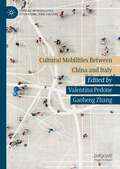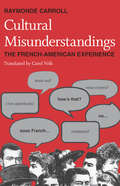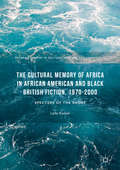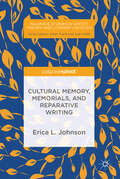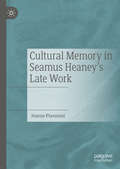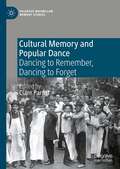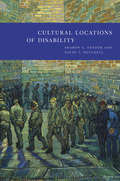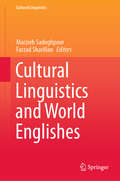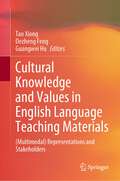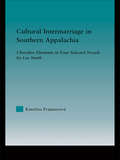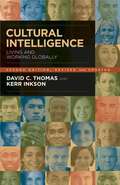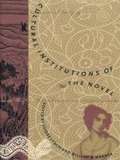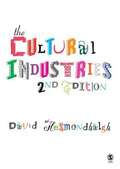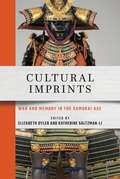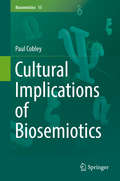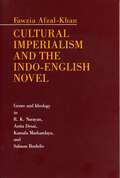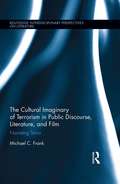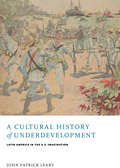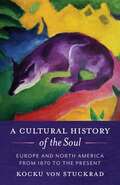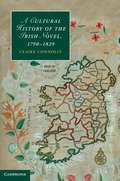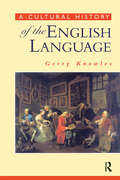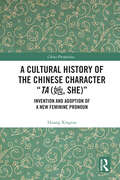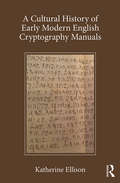- Table View
- List View
Cultural Mobilities Between China and Italy (Studies in Mobilities, Literature, and Culture)
by Valentina Pedone Gaoheng ZhangThis book offers a critical analysis of global mobilities across China and Italy in history. In three periods in the twentieth century, new patterns of physical mobilities and cultural contact were established between the two countries which were either novel at the time of their emergence or impactful on subsequent periods. The first two chapters provide overviews of writings by Italians in China and by Chinese in Italy in the twentieth century. The remaining chapters cover: Republican China’s relationships with Italy and Italian Fascist colonialism in China during the 1920s–1930s; Italian travelers to China during the Cold War from the 1950s to the 1970s; migrations between China and Italy during the 2000s–2010s. In analyzing these cultural mobilities, this book opens a new line of inquiry in Chinese-Italian Cultural Studies, which has been dominated by historical study, and contributes a significant case study to the scholarship on global cultural mobilities.
Cultural Misunderstandings: The French-American Experience
by Raymonde Carroll translated by Carol VolkRaymonde Carroll presents an intriguing and thoughtful analysis of the many ways French and Americans—and indeed any members of different cultures—can misinterpret each other, even when ostensibly speaking the same language. Cultural misunderstandings, Carroll points out, can arise even where we least expect them—in our closest relationships. The revealing vignettes that Carroll relates, and her perceptive comments, bring to light some fundamental differences in French and American presuppositions about love, friendship, and raising children, as well as such everyday activities as using the telephone or asking for information.
Cultural Misunderstanding: The French-American Experience
by Carol Volk Raymond CarrollMy studies in anthropology had not entirely prepared me. From something theoretical and exciting, anthropology abruptly became something difficult to live.
The Cultural Memory of Africa in African American and Black British Fiction, 1970-2000
by Leila KamaliThis book offers a new approach to reading the cultural memory of Africa in African American fiction from the post-Civil Rights era and in Black British fiction emerging in the wake of Thatcherism. The critical period between the decline of the Civil Rights Movement and the dawn of the twenty-first century saw a deep contrast in the distinctive narrative approaches displayed by diverse African diaspora literatures in negotiating the crisis of representing the past. Through a series of close readings of literary fiction, this work examines how the cultural memory of Africa is employed in diverse and specific negotiations of narrative time, in order to engage and shape contemporary identity and citizenship. By addressing the practice of "remembering" Africa, the book argues for the signal importance of the African diaspora's literary interventions, and locates new paradigms for cultural identity in contemporary times.
Cultural Memory, Memorials, and Reparative Writing (Palgrave Studies in Affect Theory and Literary Criticism)
by Erica L. JohnsonCultural Memory, Memorials, and Reparative Writing examines the ways in which memory furnishes important source material in the three distinct areas of critical theory, memoir, and memorial art. The book first shows how affect theorists have increasingly complemented more traditional archival research through the use of “academic memoir.” This theoretical piece is then applied to memoir works by Caribbean writers Dionne Brand and Patrick Chamoiseau, and the final case study in the book interprets as memorial art Kara Walker’s ephemeral 80,000 pound sugar sculpture of 2014. Memory as method; memory as archive; memorial as affect: this book looks at the interplay between archival sources on the one hand, and the affective memories, both personal and collective, that flow from, around, and into the constantly shifting record of the past.
Cultural Memory in Seamus Heaney’s Late Work
by Joanne PiavaniniCultural Memory in Seamus Heaney’s Late Work considers the ways that memory functions in Heaney’s poetry. Joanne Piavanini argues that the shaping of collective memory is one of Heaney’s major contributions as a poet. Locating Heaney in a transnational literary sphere, this book argues that his late work isdefined by a type of cosmopolitanism openness: the work moves beyond national identity to explore multiple allegiances and identifications. Moreover, Piavanini demonstrates that memory is a helpful lens to look at Heaney’s late work, in particular, because of the interplay of past, present and future in these works: in the construction of a collective memory of the Troubles; in the use of the elegy to commemorate the passing of important contemporary poets; in his writing on events with transnational significance, such as 9/11; in the slippages between past and present in poems about his family; and through the literary afterlives of texts—specifically, his appropriation of canonical classical texts. Drawing on approaches and concepts from memory studies, Piavanini considers Heaney’s late work to develop an analysis of poetry as a vehicle of memory.
Cultural Memory and Popular Dance: Dancing to Remember, Dancing to Forget (Palgrave Macmillan Memory Studies)
by Clare ParfittThis book focuses on the myriad ways that people collectively remember or forget shared pasts through popular dance. In dance classes, nightclubs, family celebrations, tourist performances, on television, film, music video and the internet, cultural memories are shared and transformed by dancing bodies adapting yesterday’s steps to today’s concerns. The book gathers emerging and seasoned scholarly voices from a wide range of geographical and disciplinary perspectives to discuss cultural remembering and forgetting in diverse popular dance contexts. The contributors ask: how are Afro-diasporic memories invoked in popular dance classes? How are popular dance genealogies manipulated and reclaimed? What is at stake for the nation in the nationalizing of folk and popular dances? And how does mediated dancing transmit memory as feelings or affects? The book reveals popular dance to be vital to cultural processes of remembering and forgetting, allowing participants to pivot between alternative pasts, presents and futures.
Cultural Locations of Disability
by David T. Mitchell Sharon L. SnyderIn Cultural Locations of Disability, Sharon L. Snyder and David T. Mitchell trace how disabled people came to be viewed as biologically deviant. The eugenics era pioneered techniques that managed "defectives" through the application of therapies, invasive case histories, and acute surveillance techniques, turning disabled persons into subjects for a readily available research pool. In its pursuit of normalization, eugenics implemented disability regulations that included charity systems, marriage laws, sterilization, institutionalization, and even extermination. Enacted in enclosed disability locations, these practices ultimately resulted in expectations of segregation from the mainstream, leaving today's disability politics to focus on reintegration, visibility, inclusion, and the right of meaningful public participation. Snyder and Mitchell reveal cracks in the social production of human variation as aberrancy. From our modern obsessions with tidiness and cleanliness to our desire to attain perfect bodies, notions of disabilities as examples of human insufficiency proliferate. These disability practices infuse more general modes of social obedience at work today. Consequently, this important study explains how disabled people are instrumental to charting the passage from a disciplinary society to one based upon regulation of the self.
Cultural Linguistics and World Englishes (Cultural Linguistics)
by Marzieh Sadeghpour Farzad SharifianThis book investigates the study of World Englishes from the perspective of Cultural Linguistics, a theoretical and analytical framework for cultural cognition, cultural conceptualisations and language that employs and expands on the analytical tools and theoretical advancements in a number of disciplines, including cognitive psychology/science, anthropology, distributed cognition, and complexity science. The field of World Englishes has long focused on the sociolinguistic and applied linguistic study of varieties of English. Cultural Linguistics is now opening a new venue for research on World Englishes by exploring cultural conceptualisations underlying different varieties of English. The book explores ways in which the analytical framework of Cultural Linguistics may be employed to study varieties of English around the globe.
Cultural Knowledge and Values in English Language Teaching Materials: (Multimodal) Representations and Stakeholders
by Tao Xiong Dezheng Feng Guangwei HuThis book provides a contextualized and balanced look into the timely topic of values in English Language Teaching (ELT) materials with a primary focus on the Chinese context. It features three distinct conceptual and methodological perspectives, namely, perceptions of stakeholders such as material writers, teachers and students, multimodal construction of values, and textual representation of values. It is a valuable resource for those interested in the social, cultural, moral, and ideological dimensions of English education in general, and in the textual and multimodal construction of values in language teaching materials in particular.
Cultural Intermarriage in Southern Appalachia: Cherokee Elements in Four Selected Novels by Lee Smith (Indigenous Peoples and Politics)
by Katerina PrajznerovaFirst Published in 2003. Routledge is an imprint of Taylor & Francis, an informa company.
Cultural Intelligence: Living and Working Globally
by David C. Thomas Kerr InksonGlobalization means that managers need to be prepared to do business with people from a wide range of cultures. But it's just not possible to learn the particular customs and traits of every culture you might regularly come into contact with.
Cultural Institutions of the Novel
by Deidre Lynch William B. WarnerThe story of the development of the novel--its origin, rise, and increasing popularity as a narrative form in an ever-expanding range of geographic and cultural sites--is familiar and, according to the contributors to this volume, severely limited. In a far-reaching blend of comparative literature and transnational cultural studies, this collection shifts the study of the novel away from a consideration of what makes a particular narrative a novel to a consideration of how novels function and what cultural work they perform--from what novels are, to what they do.The essays in Cultural Institutions of the Novel find new ways to analyze how a genre notorious for its aesthetic unruliness has become institutionalized--defined, legitimated, and equipped with a canon. With a particular focus on the status of novels as commodities, their mediation of national cultures, and their role in transnational exchange, these pieces range from the seventeenth century to the present and examine the forms and histories of the novel in England, Nigeria, Japan, France, New Zealand, Canada, and the United States. Works by Jane Austen, Natsume Sôseki, Gabriel García Márquez, Buchi Emecheta, and Toni Morrison are among those explored as Cultural Institutions of the Novel investigates how theories of "the" novel and disputes about which narratives count as novels shape social struggles and are implicated in contests over cultural identity and authority.Contributors. Susan Z. Andrade, Lauren Berlant, Homer Brown, Michelle Burnham, James A. Fujii, Nancy Glazener, Dane Johnson, Lisa Lowe, Deidre Lynch, Jann Matlock, Dorothea von Mücke, Bridget Orr, Clifford Siskin, Katie Trumpener, William B. Warner
The Cultural Industries
by David Hesmondhalgh'The first edition of The Cultural Industries moved us irrevocably past the tired debates between political economy and cultural studies approaches. This second edition takes on new and vital targets, for example claims that the Internet is replacing television in everyday media consumption. . . . In the process, Hesmondhalgh provides us with an essential toolkit for making critical sense of the digital media age, and our places within it' - Nick Couldry, Goldsmiths College, University Of London 'This book sets a valuable standard for communication studies. Hesmondhalgh integrates cultural research with political economy, organizational sociology with public communication policy studies, global with comparative analysis, and intellectual property law with technology changes. I've successfully taught graduate and undergraduate courses in the USA and France using the first edition, and this one is better still' - John D. H. Downing, Global Media Research Centre, Southern Illinois University Praise for the first edition: 'This lucid, careful and sophisticated book orders the entire field, for the US as well as Europe, and at one stroke becomes the state of the art, the standard' - Todd Gitlin, Columbia University, USA This book is a powerful antidote to journalistic hype about change in the cultural industries. Significantly expanding, updating and revising an acclaimed first edition published in 2002, it · analyses how, why and in what ways cultural production has changed since the 1980s · guides the reader through existing approaches · scrutinises facts and debates about the role of culture and creativity in modern societies · provides new material on copyright, cultural policy, celebrity power, the digital distribution of music and many other issues Like its predecessor, this exciting new edition of The Cultural Industries places transformation in the cultural industries in long-term political, economic and cultural context. In doing so, Hesmondhalgh offers a distinctive critical approach to cultural production, drawing on political economy perspectives, but also on cultural studies, sociology and social theory.
Cultural Imprints: War and Memory in the Samurai Age
by Elizabeth OylerCultural Imprints draws on literary works, artifacts, performing arts, and documents that were created by or about the samurai to examine individual "imprints," traces holding specifically grounded historical meanings that persist through time. The contributors to this interdisciplinary volume assess those imprints for what they can suggest about how thinkers, writers, artists, performers, and samurai themselves viewed warfare and its lingering impact at various points during the "samurai age," the long period from the establishment of the first shogunate in the twelfth century through the fall of the Tokugawa in 1868. The range of methodologies and materials discussed in Cultural Imprints challenges a uniform notion of warrior activity and sensibilities, breaking down an ahistorical, monolithic image of the samurai that developed late in the samurai age and that persists today. Highlighting the memory of warfare and its centrality in the cultural realm, Cultural Imprints demonstrates the warrior's far-reaching, enduring, and varied cultural influence across centuries of Japanese history.Contributors: Monica Bethe, William Fleming, Andrew Goble, Thomas Hare, Luke Roberts, Marimi Tateno, Alison Tokita, Elizabeth Oyler, Katherine Saltzman-Li
Cultural Implications of Biosemiotics (Biosemiotics #15)
by Paul CobleyThis is the first book to consider the major implications for culture of the new science of biosemiotics. The volume is mainly aimed at an audience outside biosemiotics and semiotics, in the humanities and social sciences principally, who will welcome elucidation of the possible benefits to their subject area from a relatively new field. The book is therefore devoted to illuminating the extent to which biosemiotics constitutes an 'epistemological break' with 'modern' modes of conceptualizing culture. It shows biosemiotics to be a significant departure from those modes of thought that neglect to acknowledge continuity across nature, modes which install culture and the vicissitudes of the polis at the centre of their deliberations. The volume exposes the untenability of the 'culture/nature' division, presenting a challenge to the many approaches that can only produce an understanding of culture as a realm autonomous and divorced from nature.
Cultural Imperialism and the Indo-English Novel: Genre and Ideology in R. K. Narayan, Anita Desai, Kamala Markandaya, and Salman Rushdie
by Fawzia Afzal-KhanCultural Imperialism and the Indo-English Novel focuses on the novels of R. K. Narayan, Anita Desai, Kamala Markandaya, and Salman Rushdie and explores the tension in these novels between ideology and the generic fictive strategies that shape ideology or are shaped by it. Fawzia Afzal-Khan raises the important question of how much the usage of certain ideological strategies actually helps the ex-colonized writer deal effectively with postcolonial and postindependence trauma and whether or not the choice of a particular genre or mode employed by a writer presupposes the extent to which that writer will be successful in challenging the ideological strategies of "containment" perpetuated by most Western "orientalist" texts and writers. She argues that the formal or generic choices of the four writers studied here reveal that they are using genre as an ideological "strategy of liberation" to help free their peoples and cultures from the hegemonic strategies of "containment" imposed upon them. She concludes that the works studied here constitute an ideological rebuttal of Western writers' denigrating "containment" of non-Western cultures. She also notes that self-criticism, as implied in Rushdie's works, is not be confused with self-hatred, a theme found in Naipaul's work.
The Cultural Imaginary of Terrorism in Public Discourse, Literature, and Film: Narrating Terror (Routledge Interdisciplinary Perspectives on Literature)
by Michael C. FrankThis study investigates the overlaps between political discourse and literary and cinematic fiction, arguing that both are informed by, and contribute to, the cultural imaginary of terrorism. Whenever mass-mediated acts of terrorism occur, they tend to trigger a proliferation of threat scenarios not only in the realm of literature and film but also in the statements of policymakers, security experts, and journalists. In the process, the discursive boundary between the factual and the speculative can become difficult to discern. To elucidate this phenomenon, this book proposes that terror is a halfway house between the real and the imaginary. For what characterizes terrorism is less the single act of violence than it is the fact that this act is perceived to be the beginning, or part, of a potential series, and that further acts are expected to occur. As turn-of-the-century writers such as Stevenson and Conrad were the first to point out, this gives terror a fantastical dimension, a fact reinforced by the clandestine nature of both terrorist and counter-terrorist operations. Supported by contextual readings of selected texts and films from The Dynamiter and The Secret Agent through late-Victorian science fiction to post-9/11 novels and cinema, this study explores the complex interplay between actual incidents of political violence, the surrounding discourse, and fictional engagement with the issue to show how terrorism becomes an object of fantasy. Drawing on research from a variety of disciplines, The Cultural Imaginary of Terrorism will be a valuable resource for those with interests in the areas of Literature and Film, Terrorism Studies, Peace and Conflict Studies, Trauma Studies, and Cultural Studies.
A Cultural History of Underdevelopment: Latin America in the U.S. Imagination (New World Studies)
by John Patrick LearyA Cultural History of Underdevelopment explores the changing place of Latin America in U.S. culture from the mid-nineteenth century to the recent U.S.-Cuba détente. In doing so, it uncovers the complex ways in which Americans have imagined the global geography of poverty and progress, as the hemispheric imperialism of the nineteenth century yielded to the Cold War discourse of "underdevelopment." John Patrick Leary examines representations of uneven development in Latin America across a variety of genres and media, from canonical fiction and poetry to cinema, photography, journalism, popular song, travel narratives, and development theory. For the United States, Latin America has figured variously as good neighbor and insurgent threat, as its possible future and a remnant of its past. By illuminating the conventional ways in which Americans have imagined their place in the hemisphere, the author shows how the popular image of the United States as a modern, exceptional nation has been produced by a century of encounters that travelers, writers, radicals, filmmakers, and others have had with Latin America. Drawing on authors such as James Weldon Johnson, Willa Cather, and Ernest Hemingway, Leary argues that Latin America has figured in U.S. culture not just as an exotic "other" but as the familiar reflection of the United States' own regional, racial, class, and political inequalities.
A Cultural History of Translation in Early Modern Japan
by Rebekah ClementsThe translation of texts has played a formative role in Japan's history of cultural exchange as well as the development of literature, and indigenous legal and religious systems. This is the first book of its kind, however, to offer a comprehensive survey of the role of translation in Japan during the Tokugawa period, 1600-1868. By examining a wide range of translations into Japanese from Chinese, Dutch and other European texts, as well as the translation of classical Japanese into the vernacular, Rebekah Clements reveals the circles of intellectual and political exchange that existed in early modern Japan, arguing that, contrary to popular belief, Japan's 'translation' culture did not begin in the Meiji period. Examining the 'crisis translation' of military texts in response to international threats to security in the nineteenth century, Clements also offers fresh insights into the overthrow of the Tokugawa shogunate in 1868.
A Cultural History of the Soul: Europe and North America from 1870 to the Present
by Kocku von StuckradThe soul, which dominated many intellectual debates at the beginning of the twentieth century, has virtually disappeared from the sciences and the humanities. Yet it is everywhere in popular culture—from holistic therapies and new spiritual practices to literature and film to ecological and political ideologies. Ignored by scholars, it is hiding in plain sight in a plethora of religious, psychological, environmental, and scientific movements.This book uncovers the history of the concept of the soul in twentieth-century Europe and North America. Beginning in fin de siècle Germany, Kocku von Stuckrad examines a fascination spanning philosophy, the sciences, the arts, and the study of religion, as well as occultism and spiritualism, against the backdrop of the emergence of experimental psychology. He then explores how and why the United States witnessed a flowering of ideas about the soul in popular culture and spirituality in the latter half of the century.Von Stuckrad examines an astonishingly wide range of figures and movements—ranging from Ernest Renan, Martin Buber, and Carl Gustav Jung to the Esalen Institute, deep ecology, and revivals of shamanism, animism, and paganism to Rachel Carson, Ursula K. Le Guin, and the Harry Potter franchise. Revealing how the soul remains central to a culture that is only seemingly secular, this book casts new light on the place of spirituality, religion, and metaphysics in Europe and North America today.
A Cultural History of the Irish Novel, 1790–1829
by Claire ConnollyClaire Connolly offers a cultural history of the Irish novel in the period between the radical decade of the 1790s and the gaining of Catholic Emancipation in 1829. These decades saw the emergence of a group of talented Irish writers who developed and advanced such innovative forms as the national tale and the historical novel: fictions that took Ireland as their topic and setting and which often imagined its history via domestic plots that addressed wider issues of dispossession and inheritance. Their openness to contemporary politics, as well as to recent historiography, antiquarian scholarship, poetry, song, plays and memoirs, produced a series of notable fictions; marked most of all by their ability to fashion from these resources a new vocabulary of cultural identity. This book extends and enriches the current understanding of Irish Romanticism, blending sympathetic textual analysis of the fiction with careful historical contextualization.
A Cultural History of the English Language (The English Language Series)
by Gerry KnowlesThis book presents a new interpretation of the history of English. Access to large corpuses of English has allowed scholars to assess the minutiae of linguistic change with much greater precision than before, often pinpointing the beginnings of linguistic innovations in place and time. The author uses the findings from this research to relate major historical events to change in the language, in particular to areas of linguistic inquiry that have been of particular importance in recent years, such as discourse analysis, stylistics and work on pidgins and creoles. The book does not attempt to chronicle changes in syntax or pronunciation and spelling, but is designed to complement a corpus-based study of formal changes. The story of English is brought up to the late 1990s to include, amongst other things, discussions of Estuary English and the implications of the information superhighway.
A Cultural History of the Chinese Character “Ta: Invention and Adoption of a New Feminine Pronoun (China Perspectives)
by Huang XingtaoThis book offers a thorough examination of the history of a Chinese female pronoun – the Chinese character "Ta (她, She)" and demonstrates how the invention and identification of this new word is inextricably intertwined with matters of sociocultural politics. The Chinese character Ta for the third-person feminine singular pronoun was introduced in the late 1910s when the voices of women’s liberation rang out in China. The invention and dissemination of this word not only reflected an ideological gendering of the Chinese script but also provoked heated academic and popular debate well into the 1930s. Thus, the history of Ta provides a prism through which to explore modern Chinese history. The author provides an ambitious and informed examination of how Ta was invented and promoted in relation to the gender equality movement, the politics of neologism, and other domestic elements and international catalysts. This book is the first major work to survey Ta’s creation. It draws on diverse sources, including interviews with eight historians who experienced the popularisation of Ta as youths in the 1930s and 40s. This book will be an essential read for students and scholars of East Asian Studies, Chinese Cultural History, and those who are interested in the history of China.
A Cultural History of Early Modern English Cryptography Manuals
by Katherine EllisonDuring and after the English civil wars, between 1640 and 1690, an unprecedented number of manuals teaching cryptography were published, almost all for the general public. While there are many surveys of cryptography, none pay any attention to the volume of manuals that appeared during the seventeenth century, or provide any cultural context for the appearance, design, or significance of the genre during the period. On the contrary, when the period’s cryptography writings are mentioned, they are dismissed as esoteric, impractical, and useless. Yet, as this book demonstrates, seventeenth-century cryptography manuals show us one clear beginning of the capitalization of information. In their pages, intelligence—as private message and as mental ability—becomes a central commodity in the emergence of England’s capitalist media state. Publications boasting the disclosure of secrets had long been popular, particularly for English readers with interests in the occult, but it was during these particular decades of the seventeenth century that cryptography emerged as a permanent bureaucratic function for the English government, a fashionable activity for the stylish English reader, and a respected discipline worthy of its own genre. These manuals established cryptography as a primer for intelligence, a craft able to identify and test particular mental abilities deemed "smart" and useful for England’s financial future. Through close readings of five specific primary texts that have been ignored not only in cryptography scholarship but also in early modern literary, scientific, and historical studies, this book allows us to see one origin of disciplinary division in the popular imagination and in the university, when particular broad fields—the sciences, the mechanical arts, and the liberal arts—came to be viewed as more or less profitable.
